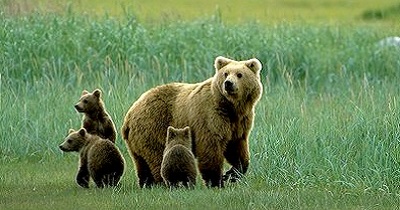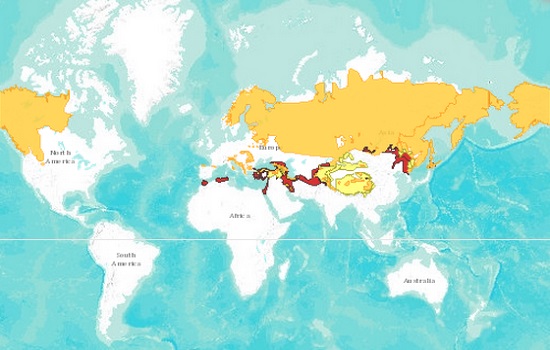Taxonomy
0
Kingdom |
Phylum |
Class |
Order |
Family |
Genus |
Species |
| Animalia | Chordata | Mammalia | Carnivora | Ursidae | Ursus | Ursus arctos |

Brown Bear family.The brown bear is also known as grizzly bear in North America and it is the most distributed species of bear on earth. Source: Alaska in Pictures
0
Name
- Common name: Brown bear, grizzly, grizzly bear.
- Scientific name: Ursus arctos.
Distribution
- The brown bear has a circumpolar distribution historically covering most of North America, northern Asia, Europe, the Atlas Mountains of North Africa and the Middle East. In most of these areas Ursus arctos is extinct or their numbers have been drastically reduced.
- The brown bear is one of the 8 species of extant bears and the most widely distributed.
- This species is one of three of the ursidae family distributed in North America, the other two are the polar bear (Ursus maritimus) and the black bear (Ursus arctos).
- Today most brown bears are found in northwest North America and Russia with population pockets in Europe.
- In North America brown bears are known as grizzly bears. They were historically distributed over most of the northwest from Alaska in the north to Mexico in the south and from the Pacific in the west to the Missouri River in the east.
- Today in North America its range is limited to Alaska, Yukon, British Columbia and smaller populations in Montana, Idaho, and Wyoming in the U.S. and Alberta and the Northwest Territories in Canada.
- The populations of southwestern U.S and Mexico are believed to be extinct.
- Today in North America there are two recognized subspecies of grizzly bears: Ursus arctos horribilis that live inland and Ursus arctos middendorffi or Kodiak bear which is found in the Kodiak Archipelago and surrounding islands off the coasts of Alaska and British Columbia.
Habitat
- Brown bears occupy a great variety of habitats from Arctic shrub lands, steppes, temperate rainforest, tundra, coastlines and alpine meadows.
- Their main habitat requirement is areas with dense coverage where they can find shelter during the day.

Brown Bear (grizzly bear) distribution map. The red areas is where the species is extinct. Source: IUCN Red List of Threatened Species
Physical Features
- Brown or grizzly bears have long and thick fur that varies in color depending on its geographical area due to temperature and diet. Its fur can range from cream to silver, brown and black.
- They have a slight hump above its shoulder.
- They have large and curved claws. Juveniles can climb trees but not adults because of their weight.
- Their large molars are adapted to crushing food.
- Body size varies greatly among subspecies of brown bears. It fluctuates according to sex, geographical location, age, season and diet.
- Those found in the coast of Alaska, British Columbia and eastern Russia are the largest.
- The largest subspecies of brown bear is the Kodiak bear that lives in the Kodiak Archipelago and surrounding islands in Alaska and British Columbia, Canada.
Weight and length
- Brown bears can weight from 881 to 3,306 lbs or 400 to 1500 kg.
- They can measure from 3.28 to 9.19 ft or 1 to 2.8 m in length from head to rump.
- Males are 10% larger than females.
Behavior
- Brown bears return to the same seasonal food sources year after year.
- They are solitary animals unless during mating season or females raising cubs.
- Occasionally they gather at major food sources where social hierarchy will prevail. Adult males are dominant followed by females with cubs over juveniles and females with no cubs.
- Brown bears have home ranges. Their size depends on distribution, food and available habitat. Home ranges tend to overlap and can be as large as 1,000 sq mi or 2,600 sq km but the average is between 28 and 160 sq mi or 73 and 415 sq km. Males have larger home range than females.
- They have low dispersal capabilities. Females disperse only 6.2 miles or 10 km and males 18.6 miles or 30km from their mother’s home range.
- In the fall they start looking for a place to build their den where they will rest for the winter.
- Some brown bears travel during the fall in search of food supplies.
- They build dens by digging under fallen trees, cavities on large trees and caves or crevices in rocks.
- It forages for food early morning and evenings and rests during the day.
- They can run at speeds of up to 35 mph or 55 km/hr.
- Depending on location and weather, brown bears begin a period of inactivity in November or December and lasts until March or April. In cold areas they go through a deep sleep which is not true hibernation as they can easily be awaken.
- They communicate by making sounds and by leaving scent marks to mark their territory. They have an acute sense of smell but poor eyesight.
- The brown bear is an apex predator.
Reproduction
- Brown bears reach reproductive maturity from between 5 to 8 years old.
- They breed between the end of April to the end of June.
- Females will take from 2 to 3 years between litters until they mate again.
- The fertilized egg is implanted in the uterus 5 months after mating depending on certain conditions such as availability of food and general health. The total gestation time lasts from 180 to 266 days including delayed implantation.
- Litter size is usually 2 to 3 sometimes up to 4.
- Males do not provide parental care.
The Young
- Cubs are born in the den between January and March while the mother is resting for the winter.
- Cubs are born blind and furless. They weight an average of 1 pound or 0.45 kilos.
- They leave the den in the spring when their mother will teach them how to survive.
- The young stay with their mothers until at least their 2nd spring, but usually until their 3rd or ever 4th
Diet
- Brown bears are omnivorous. Their diet changes with season and location.
- They eat berries, roots, grass, salmon, insects, small and large mammals and the carrion of dead animals.
Life Expectancy
- Brown or grizzly bears can live in the wild for 20 to 30 years and in captivity for up to 50 years.
Predators
- The brown bear is an apex predator. Its main predator is humans.
- Sometimes cubs become prey of other bears, mountain lions or wolves.
Threats
- Habitat conversion to agricultural lands, urban development and roads.
- Hunting, poaching and human encounters.
- Persecuted as predators of livestock.
- Mining and oil extraction pollutes their habitat.
- Fragmentation of its habitat. Brown bears need connected and large areas to ensure their survival.
Conservation Status
- They are threatened in the lower 48 states.
- The American black bear and the brown bear are the only bear species not classified as threatened by the IUCN.
- Some subspecies of brown bears such as the Californian, North Africa Atlas bear and the Mexican brown bears are extinct.
- Many subspecies like the Himalayan brown bear and the Marsican brown bear are critically endangered.
Interesting Facts about grizzly bears (brown bears)
- The brown bear is the national animal of Finland.
- The grizzly bear (brown bear) is the state animal of Montana.
- The California golden bear (Ursus californicus) was designated the state animal of California in 1953 even though it had been extinct since 1922.
- The U.S. and Canadian governments consider pepper spray a more effective weapon to stop brown bears aggressive behavior rather than guns.
- Brown bears have unpredictable behavior and may attack if they feel threatened.
Related Species
 |
 |
 |
 |
| Bear, Andean or Spectacled |
Bear, Asiatic Black |
Bear, Black | Bear, Brown |
 |
 |
 |
 |
| Bear, Giant Panda | Bear, Polar | Bear, Sloth | Bear, Sun |
References and further research
ITIS Report – Taxonomy ursus arctos
United States Department of Agriculture Wildlife Species – Ursus arctos horribilis
British Columbia Ministry of Environment – Grizzly Bear Ursus arctos
U.S. Fish and Wildlife Service Environmental Conservation Online System– Ursus arctos horribilis
